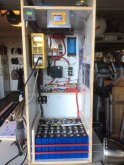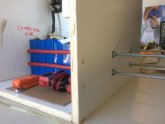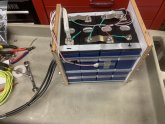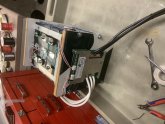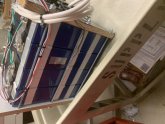Tex
New Member
- Joined
- Dec 16, 2019
- Messages
- 83
I'm wondering if anyone has experience using aluminum LiFePO4 cells in a mobile context, where road vibration, bumps, etc, are a factor. I'm especially curious whether anyone has used these cells in an overland build? How do they hold up? How does the quality of construction seem overall?
For a review on LiFePO4 in a van see my review, vibration seems to be an overrated worry, there are hundreds of thousands of various configurations of LiFePO4 batteries installed in various RV's being dragged all over the country with apparently no issues re. vibration.
Just to update, I have just finished installing a Victron BMV-712 battery monitor for peace of mind and system info. And I have enabled the built in network between the BMV-712 and the MPPT 75/15, pretty cool.
I would make two comments on this, firstly Victron manuals are written by engineers, (so they suck), but there is huge amounts of info on YouTube (but don't take any one as gospel). Secondly while a bit expensive, I am convinced it is a very worthwhile installation, heaps of config-arability, heaps of info, Bluetooth built in. One warning, as usual you get the dreaded "Firmware update required" warning as soon as you connect. I kept getting a fail error (B8), no indication from Victron as to what that actually means. However after multiple tries (5) over two days I got both the BMV-712 and the MPPT 75/15 to update, interesting they both did two updates.
I am now waiting on a Victron temp sensor to arrive, I should have bought one with the unit.
Establishing all the correct settings for the BMV-712 has been a very taxing exercise, but I believe I now have everything pretty much correct.
I am using pretty conservative numbers for my battery to extend the life, and the performance is outstanding.
I am attaching my current settings for both the BMV-712 and the MPPT 75/15, comments are welcomed.


Attachments
-
 BMV-712 - 1.png194.7 KB · Views: 13
BMV-712 - 1.png194.7 KB · Views: 13 -
 BMV-712 - 2.png177.1 KB · Views: 13
BMV-712 - 2.png177.1 KB · Views: 13 -
 BMV-712 - Relay.png173.2 KB · Views: 11
BMV-712 - Relay.png173.2 KB · Views: 11 -
 BMV-712 - SOC Alarms.png148.7 KB · Views: 7
BMV-712 - SOC Alarms.png148.7 KB · Views: 7 -
 BMV-MPPT Network.png186.2 KB · Views: 7
BMV-MPPT Network.png186.2 KB · Views: 7 -
 Charger - 1.png163.7 KB · Views: 5
Charger - 1.png163.7 KB · Views: 5 -
 Charger - 2.png160.8 KB · Views: 6
Charger - 2.png160.8 KB · Views: 6 -
 MPPT 7515 - 1.png178.5 KB · Views: 8
MPPT 7515 - 1.png178.5 KB · Views: 8



